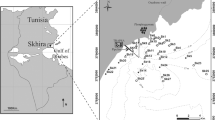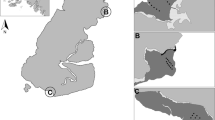Abstract
The intertidal molluscan fauna on a sandy-mud beach in Newport Bay, California, USA, is divisible into two vertically distinct species assemblages which correspond to the midlittoral zone and sublittoral fringe observed on rocky coastlines and exposed sandy beaches. The species assemblage comprising the midlittoral zone is unusual, however, in that the numerically dominant species are not confined to this zone but range downward through the sublittoral fringe. The two species assemblages are vertically separated at +0.5 to +1.0 ft (+0.15 to +0.30 m; relative to 0.0 tidal datum at mean lower low water), which is higher than previously observed for the separation between the midlittoral zone and sublittoral fringe on rocky shores and exposed sandy beaches. The species composition of some of the samples at +0.5 and +1.0 ft (+0.15 and +0.30 m) was intermediate between samples higher and lower on the beach, while several samples were devoid of molluscs altogether. Additionally, the surface sedimentary environment changes in terms of an increased percent silt-clay fraction and higher sorting coefficients below +0.5 ft (+0.15 m). Since infaunal zonation is correlated with tidal height at the substrate surface, environmental factors operative at the surface are probably most important in influencing the zonation on this beach.
Similar content being viewed by others
Literature Cited
Anonymous: Tide tables; high and low water predictions, West Coast of North and South America, including the Hawaiian Islands, 226 pp. Rockville, Maryland: U.S. Department of Commerce, National Oceanic Atmospheric Administration, National Ocean Survey 1971
Beanland, F.L.: Sand and mud communities in the Dover Estuary. J. mar. biol. Ass. U.K. 24, 589–611 (1940)
Blair, G.M. and R.R. Seapy: Selective predation and prey location in the sea slug Navanax inermis. Veliger 15, 119–124 (1972)
Bloom, S.A., J.L. Simon and V.D. Hunter: Animal-sediment relations and community analysis of a Florida estuary. Mar. Biol. 13, 43–56 (1972)
Brady, F.: The distribution of the fauna of some intertidal sands and muds on the Northumberland coast. J. Anim. Ecol. 12, 27–41 (1943)
Connell, J.H.: A predator-prey system in the marine intertidal region. I. Balanus glandula and several predatory species of Thais. Ecol. Monogr. 40, 49–78 (1970)
—: Community interactions on marine rocky intertidal shores. A. Rev. Ecol. Syst. 3, 169–192 (1972)
Dahl, E.: Some aspects of the ecology and zonation of the fauna on sandy beaches. Oikos 4, 1–27 (1952)
Doty, M.S.: Rocky intertidal surfaces. In: Treatise on marine ecology and paleoecology. Vol. 1. Ecology, pp 535–585. Ed. by J.W. Hedgpeth. New York: Geological Society of America 1957. (Mem. geol. Soc. Am. No. 67)
Eltringham, S.K.: Life in mud and sand, 218 pp. New York: Crane, Russak & Co. 1971
Inman, D.L.: Measures for describing the size distribution of sediments. J. sedim. Petrol. 22, 125–145 (1952)
Johnson, R.G.: The vertical distribution of the infauna of a sand flat. Ecology 48, 571–578 (1967).
Kosler, A.: Distributional patterns of the eulitoral fauna near the isle of Hiddensee (Baltic Sea, Rugia). Mar. Biol. 1, 266–268 (1968)
Lewis, J.R.: The ecology of rocky shores, 323 pp London: English University Press 1964
McLean, J.H.: Marine shells of southern California, 104 pp. Los Angles: County Museum of Natural History 1969 Science Series 24, zoology No 11
Morisita, M.: Measuring of interspecific association and similarity between communities. Mem. Fac., Sci. Kyushu Univ. (Ser. E) 3, 65–80 (1959)
Paine, R.T.: Intertidal community structure. Experimental Studies on the relationship between a dominant competitor and its principal predator. Oecologia (Berl.) 15, 93–120 (1974)
Pohlo, R. H.: Feeding and associated morphology in Sanguinolaria nuttallii (Bivalvia: Tellincea). Veliger 14, 298–301 (1972)
Pearse, A.S., H.J. Humm and G.W. Wharton: Ecology of sand beaches at Beaufort, North Carolina Ecol. Monogr. 12, 322–374 (1942)
Philip, K.P.: The intertidal fauna of the sandy beaches of Cochin. In: Proceedings of the Symposium on Marine Intertidal Ecology, pp 317–328. Ed. by M.R.N. Prasad. New Delhi: Indian National Science Academy 1974
Ricketts, E.F. and J. Calvin: Between Pacific tides 614 pp. 4th ed. Revised by J.W. Hedgpeth. Stanford, California: Stanford University Press 1968
Sokal, R.R. and P.H.A. Sneath: Principles in numerical taxonomy, 359 pp. San Francisco, California: Freeman 1963
Southward, A.J.: The zonation of plants and animals on rocky sea shores. Biol. Rev. 33, 137–177 (1958)
Stephen, A.C.: Studies on the Scottish marine fauna. Additional observations on the fauna of the sandy and muddy areas of the tidal zone. Trans. R. Soc. Edinb. 56 (Pt 2; No. 22) 291–306 (1930)
Stephenson, T.A. and A. Stephenson: The universal features of zonation between tide marks on rocky coasts. J. Ecol. 37, 289–305 (1949)
——: Life between tidemarks on rocky shores, 425 pp. San Francisco, California: Freeman 1972
Vassallo, M.T.: The ecology of Macoma inconspicua (Broderip & Sowerby, 1829) in central San Francisco Bay, Part 1. The vertical distribution of the Macoma community. Veliger 11, 223–234 (1970)
Vohra, F.C.: Zonation on a tropical sandy shore. J. Anim. Ecol. 40, 679–708 (1972)
Watkin, E.E.: The macrofauna of the intertidal sand of Kames Bay, Millport, Bateshire. Trans. R. Soc. Edinb. 60, 543–561 (1942)
Author information
Authors and Affiliations
Additional information
Commnicated by O. Kinne, Hamburg
Rights and permissions
About this article
Cite this article
Seapy, R.R., Kitting, C.L. Spatial structure of an intertidal molluscan assemblage on a sheltered sandy beach. Mar. Biol. 46, 137–145 (1978). https://doi.org/10.1007/BF00391529
Accepted:
Issue Date:
DOI: https://doi.org/10.1007/BF00391529




